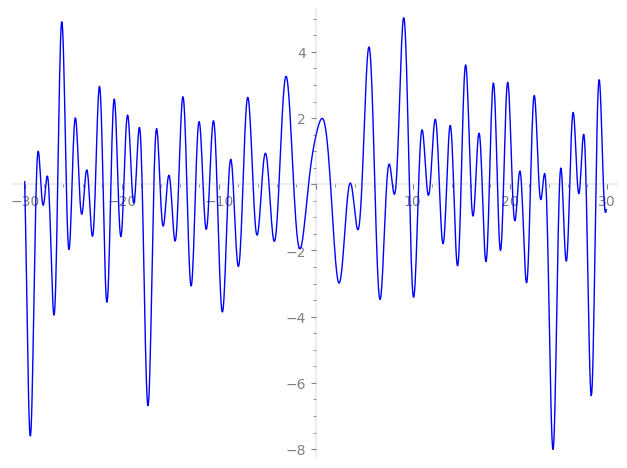| L(s) = 1 | + (0.240 + 0.240i)2-s − 1.88i·4-s + (−2.06 − 0.552i)5-s + (1.35 + 2.27i)7-s + (0.935 − 0.935i)8-s + (−0.363 − 0.629i)10-s + (−0.208 − 0.0558i)11-s + (3.58 − 0.408i)13-s + (−0.219 + 0.873i)14-s − 3.31·16-s + 5.29·17-s + (−1.66 − 6.21i)19-s + (−1.04 + 3.88i)20-s + (−0.0367 − 0.0636i)22-s − 6.44i·23-s + ⋯ |
| L(s) = 1 | + (0.170 + 0.170i)2-s − 0.942i·4-s + (−0.922 − 0.247i)5-s + (0.513 + 0.858i)7-s + (0.330 − 0.330i)8-s + (−0.115 − 0.199i)10-s + (−0.0628 − 0.0168i)11-s + (0.993 − 0.113i)13-s + (−0.0586 + 0.233i)14-s − 0.829·16-s + 1.28·17-s + (−0.381 − 1.42i)19-s + (−0.232 + 0.869i)20-s + (−0.00783 − 0.0135i)22-s − 1.34i·23-s + ⋯ |
\[\begin{aligned}\Lambda(s)=\mathstrut & 819 ^{s/2} \, \Gamma_{\C}(s) \, L(s)\cr =\mathstrut & (0.278 + 0.960i)\, \overline{\Lambda}(2-s) \end{aligned}\]
\[\begin{aligned}\Lambda(s)=\mathstrut & 819 ^{s/2} \, \Gamma_{\C}(s+1/2) \, L(s)\cr =\mathstrut & (0.278 + 0.960i)\, \overline{\Lambda}(1-s) \end{aligned}\]
Particular Values
| \(L(1)\) |
\(\approx\) |
\(1.15188 - 0.865658i\) |
| \(L(\frac12)\) |
\(\approx\) |
\(1.15188 - 0.865658i\) |
| \(L(\frac{3}{2})\) |
|
not available |
| \(L(1)\) |
|
not available |
\(L(s) = \displaystyle \prod_{p} F_p(p^{-s})^{-1} \)
| $p$ | $F_p(T)$ |
|---|
| bad | 3 | \( 1 \) |
| 7 | \( 1 + (-1.35 - 2.27i)T \) |
| 13 | \( 1 + (-3.58 + 0.408i)T \) |
| good | 2 | \( 1 + (-0.240 - 0.240i)T + 2iT^{2} \) |
| 5 | \( 1 + (2.06 + 0.552i)T + (4.33 + 2.5i)T^{2} \) |
| 11 | \( 1 + (0.208 + 0.0558i)T + (9.52 + 5.5i)T^{2} \) |
| 17 | \( 1 - 5.29T + 17T^{2} \) |
| 19 | \( 1 + (1.66 + 6.21i)T + (-16.4 + 9.5i)T^{2} \) |
| 23 | \( 1 + 6.44iT - 23T^{2} \) |
| 29 | \( 1 + (1.21 - 2.10i)T + (-14.5 - 25.1i)T^{2} \) |
| 31 | \( 1 + (0.681 + 2.54i)T + (-26.8 + 15.5i)T^{2} \) |
| 37 | \( 1 + (-2.73 + 2.73i)T - 37iT^{2} \) |
| 41 | \( 1 + (2.28 + 8.53i)T + (-35.5 + 20.5i)T^{2} \) |
| 43 | \( 1 + (4.95 - 2.85i)T + (21.5 - 37.2i)T^{2} \) |
| 47 | \( 1 + (-3.31 + 12.3i)T + (-40.7 - 23.5i)T^{2} \) |
| 53 | \( 1 + (1.97 - 3.42i)T + (-26.5 - 45.8i)T^{2} \) |
| 59 | \( 1 + (-8.64 - 8.64i)T + 59iT^{2} \) |
| 61 | \( 1 + (2.44 + 1.40i)T + (30.5 + 52.8i)T^{2} \) |
| 67 | \( 1 + (-0.436 + 1.62i)T + (-58.0 - 33.5i)T^{2} \) |
| 71 | \( 1 + (0.653 - 2.44i)T + (-61.4 - 35.5i)T^{2} \) |
| 73 | \( 1 + (-0.0329 + 0.00884i)T + (63.2 - 36.5i)T^{2} \) |
| 79 | \( 1 + (-7.28 - 12.6i)T + (-39.5 + 68.4i)T^{2} \) |
| 83 | \( 1 + (-7.72 + 7.72i)T - 83iT^{2} \) |
| 89 | \( 1 + (-5.91 - 5.91i)T + 89iT^{2} \) |
| 97 | \( 1 + (-7.90 - 2.11i)T + (84.0 + 48.5i)T^{2} \) |
| show more | |
| show less | |
\(L(s) = \displaystyle\prod_p \ \prod_{j=1}^{2} (1 - \alpha_{j,p}\, p^{-s})^{-1}\)
Imaginary part of the first few zeros on the critical line
−10.17944485724957070269115713409, −8.995666337691192998810474940470, −8.509412403493494592222286319474, −7.49899437467175903923232142810, −6.45893625624658659274617040124, −5.55812124984686861788640149803, −4.81276931823650545098169958177, −3.78419444823069073761866115681, −2.27605590782145899307280950879, −0.73961182047643664827847958007,
1.52462366513074212655945961261, 3.48061898178287654268570990030, 3.65126318993842558037889112704, 4.76614787546593972810072514480, 6.09355960102368310754215887351, 7.31397829747812253809569599870, 7.903145858182203905610731859762, 8.280438356825473751711861767567, 9.645466703845587238437757583897, 10.60804124899890555538560191290

